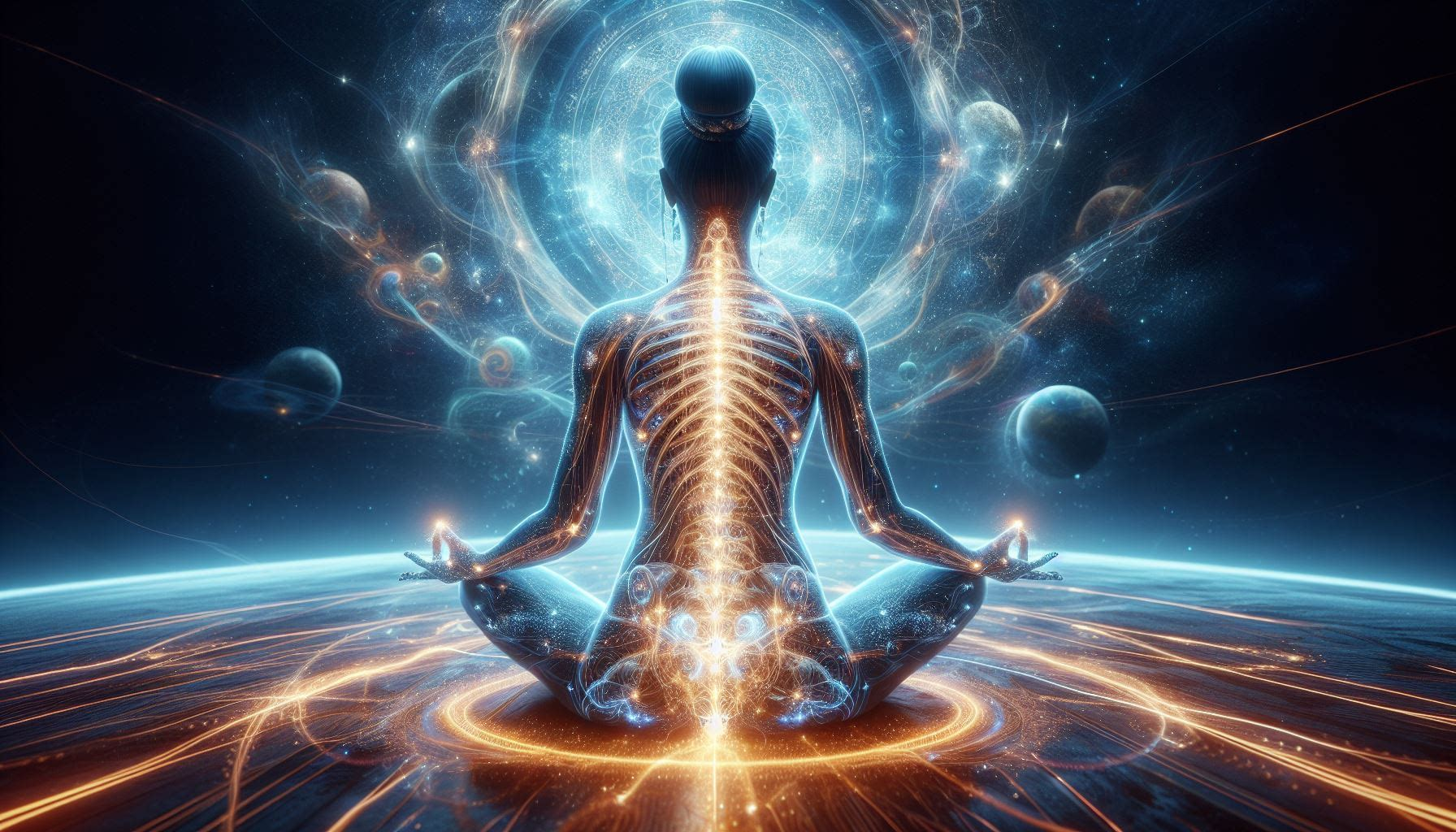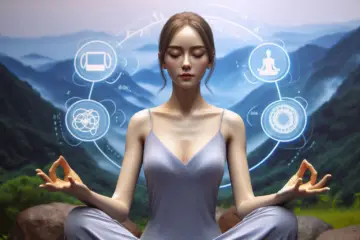Kundalini meditation isn’t just a practice; it’s a profound journey towards self-discovery and enlightenment. Unlike other forms of meditation that may focus solely on mindfulness or relaxation, Kundalini meditation dives deep into the realms of your subconscious, tapping into latent energy at the base of your spine and transforming your spiritual well-being.
This form of meditation is not for the faint-hearted. It demands dedication, openness, and a willingness to explore the depths of your inner universe. From personal experience, I can attest that embarking on this journey has been one of the most transformative experiences of my life, reshaping not just my daily routines but my very perception of reality.
What is Kundalini?
Kundalini, in yogic philosophy, is a form of divine energy believed to be located at the base of the spine. Traditionally depicted as a coiled serpent, this energy remains dormant in most individuals. However, when awakened, it can travel up through the chakras (energy centers) along the spine, leading to heightened states of consciousness and enlightenment.
The concept of Kundalini comes with its share of skepticism and intrigue, but for those who have experienced its awakening, the effects are undeniably profound.
Also read: 5 Breathing Techniques to Melt Your Stress Away
What is Kundalini Meditation?
Kundalini meditation is the process through which one aims to awaken this dormant energy. Through a combination of breath work, mantras, mudras (hand positions), and sometimes even physical postures, practitioners guide the Kundalini energy upwards through the seven chakras.
Each session can be a unique, transformative experience, often leading to emotional releases, profound insights, and a deeper sense of connection with the universe.
What are the Benefits of Kundalini Meditation?
The benefits of Kundalini meditation are vast and varied. On a physical level, regular practice can improve your respiratory system, boost your immune system, and enhance your overall vitality. Mentally, it can significantly reduce stress and anxiety, clear your mind, and increase your focus and creativity.
Spiritually, it can expand your consciousness, deepen your connection with the universe, and lead to profound experiences of enlightenment. These aren’t just lofty claims; numerous studies and personal testimonies attest to the transformative power of Kundalini meditation.
Insider Tip: For those seeking to enhance their spiritual practice, incorporating Kundalini meditation can be a game-changer. Start slow, and be patient with your progress.
How to Practice Kundalini Meditation
1. Choose a Mantra
Selecting a mantra that resonates with you is crucial. It can be as simple as “Sat Nam” (truth is my identity) or more elaborate. The mantra serves as a focal point, helping to quiet the mind and deepen your meditation.
2. Find a Comfortable Seat
Comfort is key. Sit in a cross-legged position with a straight spine, either on the floor with a cushion or on a chair with your feet flat on the ground. Ensure your posture promotes alertness yet remains relaxed.
3. Begin Breath of Fire
Breath of Fire is a rapid, rhythmic nasal breathing technique that is central to Kundalini meditation. It energizes and prepares your body for meditation, activating the Kundalini energy at the base of your spine.
4. Add a Mudra
Incorporating a mudra, or hand position, can help channel your energy and intention. Different mudras have various effects, such as Gyan Mudra for knowledge and wisdom, or Buddhi Mudra for communication.
5. Meditate for 3 Minutes
Start with three minutes of meditation, gradually increasing the duration as you become more comfortable. Focus on your mantra and the flow of your breath, allowing thoughts to pass without attachment.
Also read: How Meditation Can Make You Healthier and Ease Your Pain
Kundalini Meditation for Beginners
1. Kundalini Meditation for Beginners: The Ego Eradicator
This powerful meditation involves the Breath of Fire technique and a specific arm position to open the lungs and solar plexus, releasing pent-up ego and stress. It’s an excellent starting point for beginners.
2. Kundalini Meditation for Beginners: The Inner Sun Meditation
Focusing on the solar plexus, this meditation aims to activate your inner power and radiance. It combines breath work with visualizations of a glowing sun within, filling you with energy and confidence.
Kundalini Meditation for Anxiety
1. Kundalini Meditation for Anxiety: The Four-Part Breath
This calming meditation involves inhaling and exhaling in four equal parts, creating a rhythm that soothes the nervous system and reduces anxiety. It’s a simple yet effective technique for mental tranquility.
2. Kundalini Meditation for Anxiety: The Lotus Mudra Meditation
By adopting the Lotus Mudra and focusing on the heart chakra, this meditation fosters feelings of love, compassion, and peace, effectively countering anxiety and fostering emotional healing.
Personal Experience: Overcoming Anxiety with Kundalini Meditation
As someone who has struggled with anxiety for years, I can attest to the transformative power of Kundalini meditation in managing overwhelming feelings of worry and fear.
Finding Relief Through Four-Part Breath Technique
Every night, before bed, I practice the Four-Part Breath technique. Sitting comfortably, I close my eyes and inhale deeply for four counts, hold my breath for four counts, exhale for four counts, and hold again for four counts. This rhythmic breathing helps to calm my racing thoughts and soothe my anxious mind.
Embracing the Lotus Mudra Meditation
During particularly stressful days, I turn to the Lotus Mudra Meditation. By gently pressing the tips of my thumb and pinky finger together on both hands, I feel a sense of grounding and inner peace wash over me. As I sit in stillness, focusing on my breath and the subtle energy flowing through my body, I find relief from the grip of anxiety.
Through consistent practice of these Kundalini meditations, I have been able to cultivate a sense of serenity and balance, allowing me to navigate life’s challenges with greater ease and resilience.
Kundalini Meditation for Sleep
1. Kundalini Meditation for Sleep: The Deep Relaxation Meditation
Ideal for promoting deep, restful sleep, this meditation uses guided relaxation and visualizations to release physical and mental tension, preparing the body and mind for a rejuvenating night’s sleep.
2. Kundalini Meditation for Sleep: The Sat Kriya Meditation
Though more dynamic, the Sat Kriya meditation helps balance the body’s energy, promoting relaxation and aiding in overcoming insomnia. It’s a testament to the versatility of Kundalini practices in addressing various needs.
Kundalini Meditation for Weight Loss
1. Kundalini Meditation for Weight Loss: The Abdominal Strengthening Series
This series of exercises and breath work focuses on the abdominal area, boosting metabolism, and improving digestion, aiding in weight loss and promoting a healthy, energetic body.
2. Kundalini Meditation for Weight Loss: The Inner Fire Kriya
Targeting the navel chakra, this practice ignites the “inner fire,” enhancing willpower, burning away impurities, and supporting a balanced approach to weight loss and overall health.
Kundalini Meditation for Depression
1. Kundalini Meditation for Depression: The Kirtan Kriya
Combining mantra chanting with sequential finger movements, the Kirtan Kriya meditation has been scientifically shown to improve mood, reduce stress, and even enhance brain function, offering a powerful tool against depression.
2. Kundalini Meditation for Depression: The Ego Eradicator
Revisiting the Ego Eradicator, its benefits extend to combating depression by releasing stored emotions, reducing stress, and fostering a sense of inner peace and self-acceptance.
How to End a Kundalini Meditation Practice
Concluding your practice properly is as important as the meditation itself. Gently bring your awareness back to the present, chant a closing mantra such as “Sat Nam,” and take a moment to notice the stillness and energy within. This ritualistic end helps to seal the meditative state, carrying its benefits into your daily life.
How to Find a Kundalini Yoga Teacher
Finding the right teacher is crucial for a safe and effective Kundalini meditation practice. Look for certified instructors with experience in Kundalini Yoga, considering both in-person and online options. The International Kundalini Yoga Teachers Association is a great resource for finding qualified teachers worldwide.
Conclusion
Kundalini meditation is more than just a practice; it’s a transformative journey that can elevate your physical, mental, and spiritual well-being to new heights. While it may seem daunting at first, the path of Kundalini offers profound insights and experiences that are well worth the effort.
My journey with Kundalini meditation has been nothing short of miraculous, revealing layers of my being I never knew existed and connecting me with a universal energy that is both empowering and humbling. Whether you’re seeking to alleviate stress, explore spiritual depths, or simply cultivate a deeper sense of self, Kundalini meditation offers a rich, rewarding path to explore.
Questions & Answers
Q.What is Kundalini meditation?
A.Kundalini meditation is a practice that aims to awaken the dormant energy at the base of the spine.
Q.Who can practice Kundalini meditation?
A.Anyone interested in spiritual growth and self-awareness can practice Kundalini meditation.
Q.How do you practice Kundalini meditation?
A.Kundalini meditation involves specific breathing techniques, mantras, and movements to activate the energy centers in the body.
Q.Isn’t Kundalini meditation too advanced for beginners?
A.Kundalini meditation can be adapted for beginners with guidance from experienced practitioners and gradual practice.
Q.What are the benefits of Kundalini meditation?
A.Benefits of Kundalini meditation include increased energy, clarity of mind, emotional balance, and spiritual awakening.
Q.How often should one practice Kundalini meditation?
A.Practicing Kundalini meditation regularly, ideally daily, can help maintain the flow of energy and experience its full benefits.




